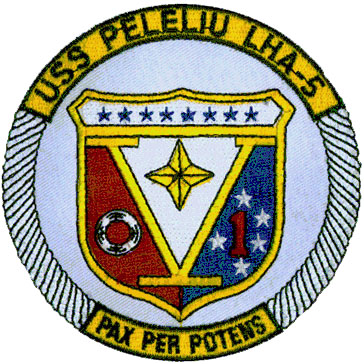LHA 5 | USS PELELIU

Namesake:Battle of Peleliu |
||||||||||||||||||||||
Historical Notes:USS PELELIU was commissioned on May 3, 1980 at Ingalls Shipyard, Pascagoula, Mississippi. The ship's sponsor was Mrs. Peggy Hayward, wife of then CNO, Thomas B. Hayward. The ship departed Ingalls Shipyard under command of CAPT T.P. Scott. Flight operations were frequently conducted and the ship logged its 500th landing on May 30, 1980. On May 17th PELELIU arrived in Colon, Panama to begin unrigging for the transit of the Panama Canal. PELELIU departed Colon on May 20th and tied up in Balboa, Panama (Pacific side of the canal) twelve hours later. After five days of rerigging in Balboa, PELELIU departed and entered her homewaters of the Pacific. PELELIU proceeded south from Panama and crossed the equator on the night of May 27th, which is the record for the shortest period between a ship's commissioning and "Crossing the Line." On May 28th PELELIU headed northerly enroute Mazatlan, Mexico, departing the Baja port on June 7th enroute San Diego, California. Most of the events PELELIU and her crew participated in during this initial transit were "firsts" and the underway refueling with USNS TALUGA was no exception, occurring on June 8th. PELELIU arrived at Naval Air Station, San Diego on June 10th for a one-day stop prior to proceeding to Long Beach, CA, her homeport. In 1981 PELELIU complete its Post-Shakedown Availability and join the fleet as a fully operational unit of the Navy's Pacific Amphibious Force. The latter part of the year found the ship and her crew well trained having past numerous work up evaluations. The Engineering department passed their Operational Propulsion Plant Examination (OPPE) in 42--hours vice the normal 72 hours required, and REFTRA was successfully accomplished just prior to the holiday season. All efforts were directed toward preparing PELELIU for its first Western Pacific/Indian Ocean deployment. 1982 marked USS PELELIU's first year as a fully operational unit of the Navy's Pacific Fleet Amphibious Force. In January, she was the flagship in a no-notice, non-combatant emergency evacuation exercise conducted off San Clemente Island, and on March 28th the ship got underway for its maiden deployment to the Western Pacific and Indian Ocean. The deployment was completed on October 4th. One month later the ship deployed to the northern Pacific Ocean to participate in an exercise held off Amchitka in the Aleutian Islands. PELELIU conducted its 10,000th accident free landing during this northern Pacific exercise. |
||||||||||||||||||||||
Ship's Crest:
|
||||||||||||||||||||||
PHOTOS
|


 The stars across the top of the shield
represent the eight Medal of Honor recipients from the Battle of
Peleliu Island in 1944. Centered is the large roman numeral "V" which
represents the hull number of the ship, LHA-5. The four point star in
the "V" identifies the four functions of the landing force, and sustain
their operations ashore. In the lower left-hand side of the shield is a
ring which by tradition of heraldry, symbolizes the fifth born. The 1st
Marine Division emblem is the constellation Southern Cross with the
numeral '1" superimposed. USS PELELIU's moto is "PAX PER POTENS", which
is "PEACE THROUGH POWER".
The stars across the top of the shield
represent the eight Medal of Honor recipients from the Battle of
Peleliu Island in 1944. Centered is the large roman numeral "V" which
represents the hull number of the ship, LHA-5. The four point star in
the "V" identifies the four functions of the landing force, and sustain
their operations ashore. In the lower left-hand side of the shield is a
ring which by tradition of heraldry, symbolizes the fifth born. The 1st
Marine Division emblem is the constellation Southern Cross with the
numeral '1" superimposed. USS PELELIU's moto is "PAX PER POTENS", which
is "PEACE THROUGH POWER".


















